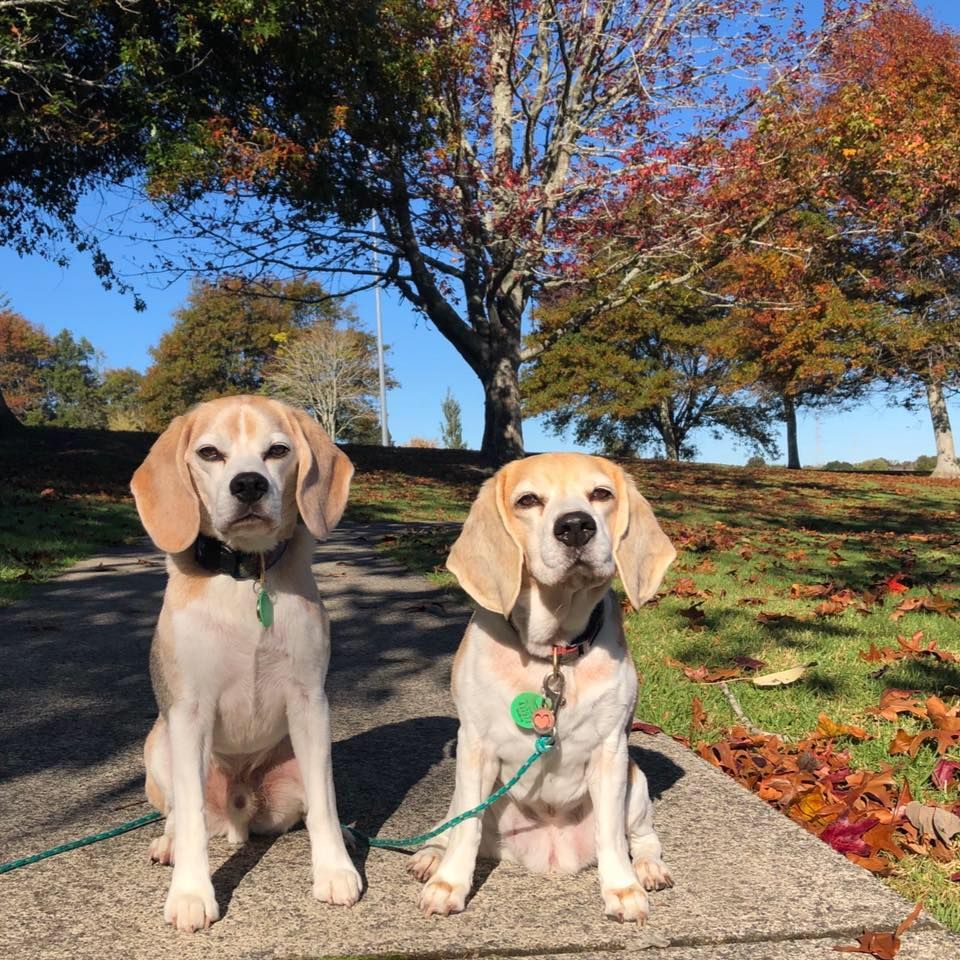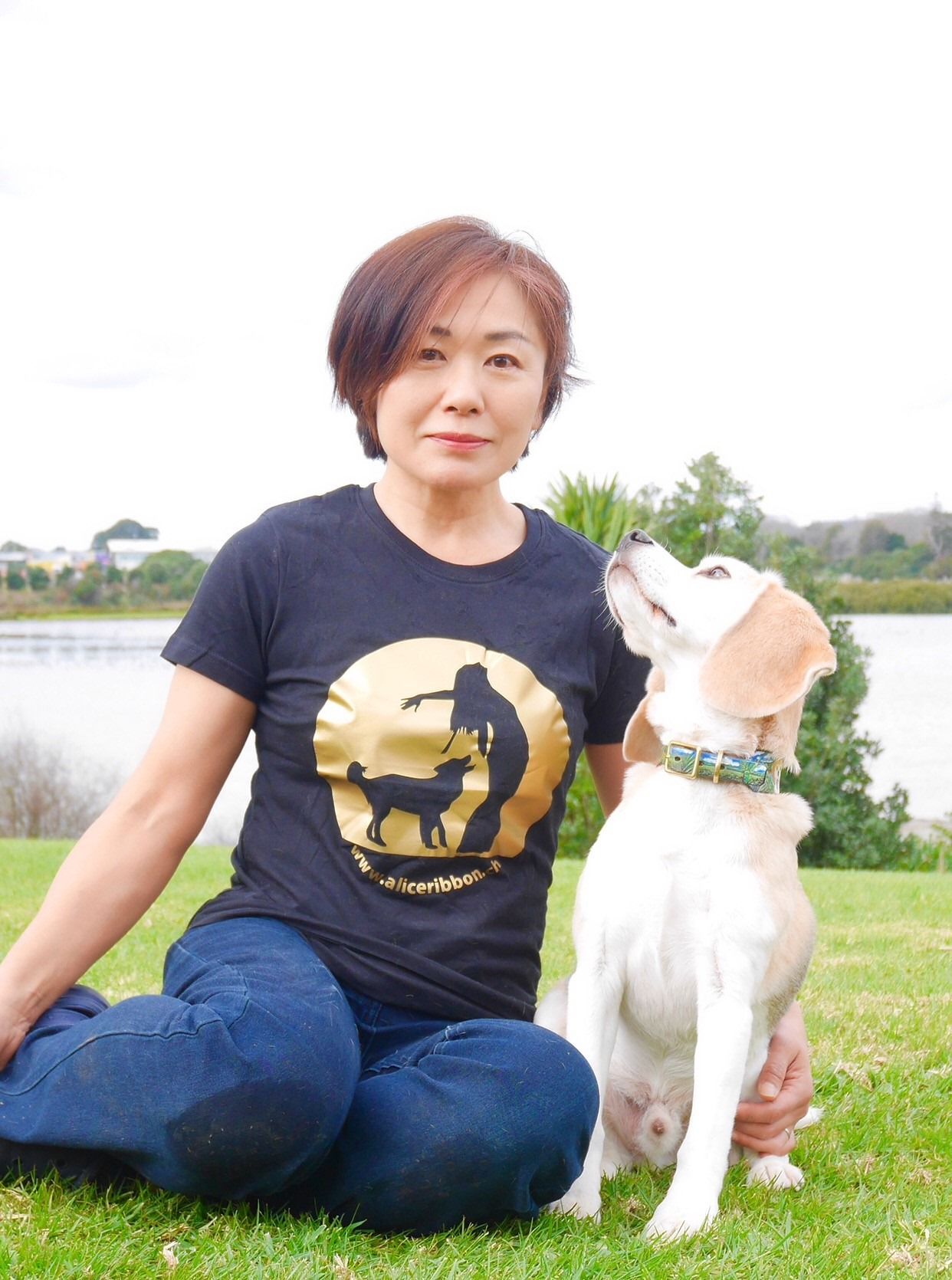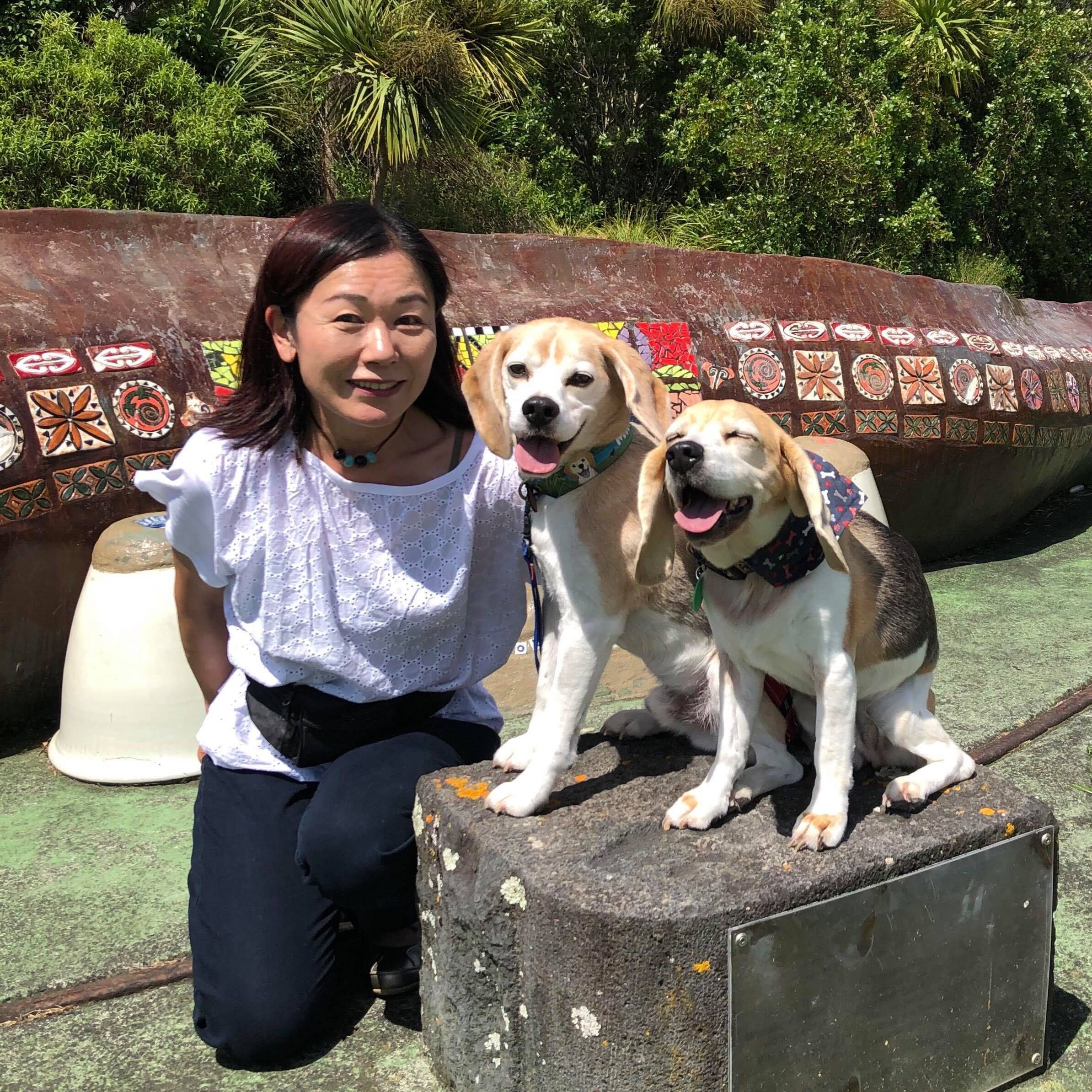We are not alone with our destiny, helplessness and grief!
We all have different ways dealing with the tragedy!
We all have learnt different lessons – positive and negative - from our dog’s cancer disease and possibly death!
As a big family, we can help each other!
The Alice-Ribbon Ambassadors
3
- 3.1. Ambassador Pepper from Japan with Asako Otsuka
- 3.2. Ambassador Chase from Belgium with Jules O’Dwyer
- 3.3. Ambassadors Spike and Savanne from France with Debra Bérnard
- 3.4. Ambassador Joy from Russia, with Natalya Rubleva
- 3.5 Ambassador Fly from the UK with Karen Sykes
- 3.6 Ambassador Shmy from Russia with Olga Kuzina
- 3.7 AMBASSADOR LOLA FROM RUSSIA WITH EVGENIYA LAZAROVA
- 3.8. AMBASSADOR LISTO FROM THE USA WITH MICHELE POULIOT
- 3.9. Ambassador Cinnomon from New Zealand with Manako Sugiyama
The power of a big family !
You will for ever stay in our hearts !
This chapter is dedicated to The Alice-Ribbon Ambassadors.
Every Ambassador-dog has been introduced below by his/her owner in their respective native language.

3.1
私は犬の脾臓にできる腫瘍について知っていました。
私のラブラドールは14歳半の時に脾臓に腫瘍が出来、手術で取り除きました。脾臓の腫瘍はその約1/3は良性と言われています。しかし、たとえ良性でも脾臓にできる腫瘍はそれ自体がもろく 破裂することがあります。
私の周りで突然亡くなった犬にこの脾臓腫瘍破裂による死も多いです。
脾臓という臓器は「老廃した血球の破壊、血中の異物や細菌の捕捉、循環血液量の調節機能と 血球の生成能をもつ」そうです。なので破裂すれば当然相当量の(致死量の)出血を伴うそうです。
私のラブラドールの腫瘍は幸いにも良性でしたが、その大きさは赤ん坊の頭位あり、1.7kgもありました。破裂しなかったのが不思議なくらいでした。腹部があまりにも膨らんでいるのでただの肥満とは思えずに獣医を受診して発見されました。
手術は成功し、それから約1年元気に過ごして15歳7か月で亡くなりました。
脾臓の腫瘍の残りの2/3は悪性で そのうちのさらに2/3は極悪性の血管肉腫と言われています。
私の大事なペッパー(ボーダーコリー)はこの血管肉腫によって亡くなりました。
ペッパーは明るく素直で とてもSweetなジェントルマンでした。シープドッグとしての素質も備えていたし、オビディエンスもしました。フリスビーはとても上手だったし、泳ぎも得意でした。私の趣味に付き合ってドッグダンスもして、海外へも行きました。彼は私のSoul mate でした。
そんなペッパーが病魔に倒れ若くして亡くなってしまったことから私は未だに立ち直れていません。
これは神様が私に与えた試練で運命です。本当はこんなストーリーを書く勇気はありませんでした。でも立ち直るきっかけになるかもしれないと思って泣きながら思い出してみます。
腫瘍が見つかったのは2016年2月25日でした。
エコー検査では少なくても直径8cmはあった。翌日、緊急に手術して腫瘍を脾臓ごと摘出し、病理検査に出し、血管肉腫と診断されました。余命は2~3か月。
獣医は 「少なくとも罹患してから数か月は経っているだろう」と言いました。思い当たることは多かったです。
2015年の夏ころから何となく元気がありませんでした。ちょうどその頃 私自身も人間関係に疲れていました。同居しているもう一頭のボーダーコリー 16歳の世話も大変でした。ペッパーも10歳になっていました。だから元気がないのじゃなくて、周りに配慮した行動なんだろうと勝手に思っていました。
10月21日に同居犬が老衰で亡くなりました。16歳4か月でした。その頃のペッパーはさらに元気がなくなっていました。だけど、私はそれを 同居犬がいなくなった寂しさからだと考えていました。老犬介護で時間が取れなかった分を取り戻そうと あちこち出かけたりしましたが、その時は楽しそうに元気なのに帰りの車中では ぐったりと寝ていました。遊びすぎたのかと思っていましたが 今思えば腫瘍から出血したことによる貧血状態だったのでしょう。摘出した腫瘍には出血をペッパー自身が治癒した痕跡がたくさん見られました。
12月ころには食事を出してもためらうようになり、ポツリポツリとのんびり食べていて、変だなとは思ったけれど 完食します。その頃サプリメントを変えたりしたので そのせいだとばかり思っていました。
時々足を痛そうにしたり、腰を痛そうにもしました。獣医にも行きましたが脾臓の腫瘍も何も、内科的なものとは思いもしませんでした。
年が明けて、オシッコがとても黄色いことが気になっていました。黄色かったのは腫瘍からの出血による溶血反応だったようです。
散歩に出てもすぐに家に帰りたがりました。貧血が進んでいてしんどかったのでしょう。
そんなになってから腫瘍が見つかりました。
早期発見できなかったと悔やんではいません。だって、血管肉腫はたとえ小さくても完治させることは難しいのを知っているから。
これは運命だったんだよ。。。認めたくないし、とても悲しいけど。
血管肉腫は 血管に由来する癌だから、当然血液に乗って体中至る所に転移するそうです。獣医からは腫瘍摘出後に抗癌剤治療を併用しても、平均150~180日生存だと言われました。
そして、日本での犬猫の抗癌剤治療の目的は完治ではなく、家で普通に過ごせる期間を延ばすことに重点が置かれているんだそうです。だから、副作用が強すぎて入院になったり、食事もとれなくなるようなら抗癌剤治療を停止することもあると説明を受けました。
なるべく普通に 快適に 穏やかな日々を少しでも長く一緒に過ごすための治療であるらしい。納得できました。
だから、美味しくて 楽しくて 泣かない日々を目指しました。
脾臓を摘出してから2か月くらいはすごく元気でした。まるで癌になんかならなかったみたいに。まるでこれですっかり治ったみたいに。
昔の元気で陽気なペッパーでした。
でも、私の心は傷つきました。知識のない善意からのお見舞いの言葉が 心に突き刺さった。「全部とれたのなら大丈夫」「きっと治るから」「奇跡が起きるよ」・・・
4月30日のエコーで肝臓に2cm大の転移が2個見つかり、それから転移腫瘍は抗癌剤の効き目なく増え、肥大していきました。亡くなる直前にはお腹は腫瘍でごつごつしていました。
5月末くらいから微熱 下痢 貧血 食欲不振 が繰り返されるようになり、抗癌剤治療は停止されステロイドを中心とした緩和ケアに移行しました。
貧血による酸欠もおき 息苦しくなってきたので高酸素ハウスもレンタルしました。
最後はほとんど食べ物を受け付けず、2016年7月5日 11歳の誕生日の2日後の早朝に息を引き取りました。
ペッパーは最後まで私を気遣ってくれました。私はペッパーにいっぱい感謝しています。
そして もう一度抱きしめたい
私は今 1歳半のジャーマンシェパードと暮らしています。この子がこの先どんな病にかかるか、または健康で天寿を全うできるか、見当もつきませんが、唯一私がしなくてはいけないことは 今、この瞬間を、大事にそして全力で共に過ごすことだと思っています。
Translation
My Labrador
I knew about the existence of tumors that can develop on the spleen of a dog.
As a matter of fact, my Labrador had a tumor on the spleen at the age of 14 1/2 years and it was removed by surgery. About one third of the diagnosed tumors of the of spleen (hemangiosarcoma) is said to be benign. However, even benign tumors on the spleen may burst because of their fragile constitution.
Many dogs around me suddenly die due to this splenic tumor.
The spleen seems to have the function to "evacuate dead blood cells, trap foreign bodies and kill bacteria in the blood, and has the ability to regulate the circulating blood volume and to produce blood cells". Therefore, a rupture of the deceased spleen is accompanied by a serious internal bleeding leading to the dog’s death.
My Labrador’s tumor was fortunately benign, but its size was that of a newborn's head: it weighed 1.7 kg! It was a miracle that the tumor had not ruptured. I noticed that his abdomen was very swollen, too much, to be just du to obesity. Therefore, I went to the veterinarian. And in fact, the tumor was found.
Fortunately, the surgery was successful, and he was able to live another year in good health. He died at 15 years and 7 months.
Pepper
However, 2/3 of the spleen tumors (hemangiosarcoma) are malign. Among these malign tumors, 2/3 are so called angiosarcoma growing on the blood vessels. These are extremely aggressive.
My important Pepper (border collie) died of this angiosarcoma!
Pepper was bright, happy, obedient and the sweetest gentleman one can imagine. He was also a bright sheep dog, and we practiced the canine sport obedience together. But his favorite activities were frisbee and swimming. Together we trained my favorite sport’s activity dog dance and for competitions we often travelled abroad. He was my soul mate!
I still haven’t recovered from my Pepper’s premature death, which has been the most devastating experience in my life. This tragedy seems to be a test sent by God. I have never had the courage to write about his cancer story. But I’ll try to remember all steps on our common last way. I’ll try to remember everything – while teardrops run down my cheeks. Perhaps this will help other dog owners – and me to overcome my deep grief.
The tumor was discovered on February 25, 2016.
In the ultra-sound examination showed a tumor measuring over 8 cm in diameter. The next day, Pepper underwent an emergency surgery to remove the tumor and the spleen. The pathology examination confirmed the diagnosis: angiosarcoma. Pepper’s life expectancy was 2-3 months.
The veterinarian informed me, “The tumor must have developed already several months before the first symptoms were visible.”
These words by the veterinarian recalled past events and observations:
In fact, in the summer 2015 Pepper – then 10 years old - showed some loss of vitality. I explained his fatigue by the fact that my second, 16-year-old border collie had become infirm and ailing: It took all my energy and time to look after him – and perhaps Pepper resented this.
On 21st October 2015, my second border collie – then 16 years and 4 months old - passed away. Pepper at that time became even more lethargic. But I thought it was due to grief and loneliness after the death of my older dog.
After my old dog had passed away, I tried to make up for the lost time with Pepper, and we undertook many excursions and long walks together. Pepper seemed very happy and cheerful, but whenever we returned home or to the car, Pepper went to sleep visibly exhausted. I thought I had done too much with him.
At hindsight, however, Pepper’s condition was probably due to an internal bleeding of his tumor. As a matter of fact, scares on the spleen, which had been removed after the surgery, could be seen.
Around December of the same year, Pepper lost appetite, became food-picky. But since after some hesitation he had eaten his portion, I was contented. I explained his loss of appetite by the fact that I had started adding a new supplement to his food.
Moreover, I noticed that Pepper at that time showed some discomfort and pain in his legs and hips. So, I went to the veterinarian to show him Pepper’s condition, but I would never have linked these symptoms to an internal decease, such as a cancer on the spleen.
At the beginning of the new year, I was stunned to see that the color of his urine had
turned dark yellow. It seems that this is due to a physical reaction to an internal bleeding.
When we went for one his long walks, which he normally loved so much, he just wanted to return home. I believe that Pepper at this time suffered from anemia due to an internal bleeding.
Finally, the tumor was discovered.
I don’t have any regrets: it was impossible to find the tumor at an earlier stage, because I know that angiosarcoma is fatal in any case, even if found early when still small.
Is was just destiny. . . However, I find it very difficult to accept - I am very sad.
Because angiosarcoma is a cancer derived from blood vessels, it seems that it will - by its nature - enter the blood circulation and create metastasis all over the body. The veterinarian told me that dogs might only survive an average of 150 to 180 days, even after the surgical removal of the tumor followed by chemo-therapy.
Moreover, the veterinarian explained that the purpose of chemo-therapy for dogs and cats in Japan is not to completely cure the animal, but to prolong their average life expectancy and the time the pet can stay comfortably and peacefully at home. Therefore, the vet explained, it might be necessary to interrupt the chemo-therapy because the side effects become too painful: the dog loses appetite, suffers nausea or risks hospitalization.
This convinced me to spend the last few days with Pepper as comfortably and enjoyably as possible – just we two – and I tried not to cry.
For about 2 months, Pepper felt very well indeed after the surgical removal of the spleen. He seemed as if he had never had been diagnosed with cancer. He seemed completely cured. Pepper was transformed back to the cheerful and happy dog of the past.
But my heart bleed with grief. All good intentions to console me and show sympathy didn’t really help, on the contrary. Sentences like: "Everything will be all right!" "Pepper will cure!" "Cheer up, miracles happen!” just broke my heart, because I knew that they were not true, alas.
On April 30th, 2016, Pepper was ultra-sound-screened and two metastases of about 2 cm in size were found on the liver. The metastases had unfortunately grown despite chemo-therapy. Just before his death, big tumors had also developed in his belly.
Then, by the end of May 2016, Pepper showed heavy side effects such as fever, anemia and loss of appetite Therefore the chemo-therapy was stopped, and we changed to palliative/hospice care centered on steroids.
Because of the massive loss of blood, Pepper suffered from oxygen starvation and therefore I rented an oxygen tent.
In the end on his life, Pepper couldn’t eat anymore.
Pepper took his last breath early in the morning on July 5, 2016, two days after his 11th birthday.
Pepper cared for me until the end, and I will be thankful to him for all my life. I loved Pepper so much and I miss him more than words can say. I just want to hug you again, my darling.
Life goes on: I am currently living with German Shepherd, one and a half years old. I have no idea what kind of disease this darling will suffer in the future or how long he will live, but the only thing I have to do now is to spend this very moment together - with all my strength, love and care.
Asako Otsuka


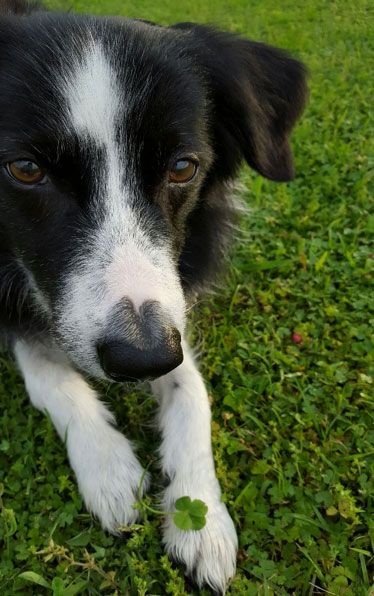
3.2
Border Collie - born 02/06/2008 – passed away 29/10/2017
My name is Jules O'Dwyer, I am a professional trainer for assistance and guide dogs for the blind, My work place is my home in Belgium, which offers a favourable situation for the working dogs in training who live alongside my own beloved family dogs.
All my dogs are special: some are old, some are rescued, some are planned and some just happened... Chase was one that I felt came into this world just for me… 😊 He was bred by my best friend and coach Christine Matheus, and I have been with him from the very first moment when he was born
I have competed in Dog Dance - in both Freestyle & Heelwork to music - as a hobby for many years and have had some very special moments, achieving some important international titles on the highest levels. But most importantly, I share every minute of my free time with my furies, training, playing, travelling and enjoying performing together.
I have been very fortunate in the last years to be able to compete with two very different characters of dogs: Matisse and Chase.
“Chase was my talented Heelwork-to-Music-dog.”
Chase was a mummy’s boy, and wherever I went, even if I only left a room, Chase would follow me. He knew every of my thoughts, he lived to make me smile, whenever I turned to look at him, in whatever situation, he was looking right back at me. He was very special.
Chase has never been sick or injured, he was naturally fit and had a great condition, a real athlete, he was fed a quality diet his whole life.
It all happened in a very short space of time: At the end of August, Chase and I stood together on the winner’s podium in Leipzig, where he had won the Open European Championship in Heelwork to Music. And only 8 weeks later our lives were to change dramatically.
At the end of October 2017, I had left home for a film shooting in Poland. Chase wasn’t happy at all, to say the least, about being left back at home while two other dogs were accompanying me on the trip.
As soon as I arrived in Warsaw, I called home and was told that Chase was still sulking. However, as a consolation he was promised a walk in the woods by my partner, just the two of them in blissful togetherness, to cheer him up.
However, on this walk Chase suddenly collapsed, one kilometre from home. My partner had to carry his unconscious body in an uphill struggle. Finally home, Chase still being unconscious, my partner loaded him into the car and rushed to our vet
Our veterinarian quickly determined with an ultrasound scan that the pericardium, the sack surrounding the heart, was filled with blood, putting the heart under pressure as it didn’t have the room it needed to fill it with the blood it had to pump.
We are very lucky to have a canine heart specialist in our area: He did further tests, and decided that if the situation worsened he would have to perform a pericardial tap, to drain the blood and allow the heart to function.
Meanwhile, Chase had come around and was acting like nothing had happened. The heart specialist didn’t want to risk doing the puncture, a life-threatening procedure in itself, until he knew more about what had caused it.
Before his collapse, Chase hadn’t shown any symptoms what so ever, no pain or discomfort, no lethargy, no lack of appetite, nothing. As a matter of fact, he was the fittest he had ever been until this first collapse.
The following day he collapsed a second time, so he was rushed to the clinic to have the pericardial tap and so to relieve the pressure around his heart. The procedure was a success, Chase lay still on command throughout the operation, with only local anaesthetics to numb the area of the puncture. He was very brave!
I was still Warsaw and hadn’t been informed about the first collapse: I was too far away, and working, so I was kept in the dark to spare me the stress and panic. But after the second collapse and after the specialist had been forced to perform the tap, my vet insisted I was brought up to date, just in case it all went wrong.
Chase was back to normal and on my return flight I felt elated with the positive news: The blood hadn’t returned, they had found no tumours anywhere. I was full of hope and couldn’t get home fast enough to finally hold my boy.
Alas, my elation was short lived, he collapsed a third time that afternoon!
This time, the blood had returned in only 2 hours since the last ultrasound scan, only now double the amount as before the puncture! The heart was now pushed by the blood into a tiny. And what more is: now something else became visible: An aggressive tumour (hemangiosarcoma metastasis) was attached to his heart.
We knew this was the end: There was nothing left to do. So, we decided to spend the
time we had left just glued to each other.
48 hours later, Chase woke me up at 6am. We had slept together on the sofa and now he stood pointing towards the door: he wanted to go outside. I walked with him down to the grass field, chatting to him when he collapsed a last time, mid trot.
I gathered him up into my arms, he took 3 short breaths, and then he stopped. He had lost his brave battle and had to leave us.... anger, frustration and disbelief!
My only consolation is that everything happened so fast, Chase showed no signs of stress or panic, I don’t think he was aware of anything when he collapsed so suddenly - other than my voice and soft kisses hopefully...
From the first collapse to the last, only one short week had passed., just seven days from first incident, diagnosis and to his departure!
This was probably the worst experience in my life and I am still having a tough time after losing my special boy.
Chase will be remembered fondly by many, not just for his Heelwork to music achievements but also for his role in winning Britain’s got talent (he was the famous tightrope walking dog).
To us, he was a family dog, he was my dog in a million, I am grateful he was a part of my life and we spent so many happy times together, I’m only sorry he didn’t get to be an old dog, he was robbed of that.
9 years old is not old, but whatever short time he had to live, this time was certainly quality time.
Rest in peace my wonderful, handsome Chayko, I will miss you forever!
Jules O’Dwyer
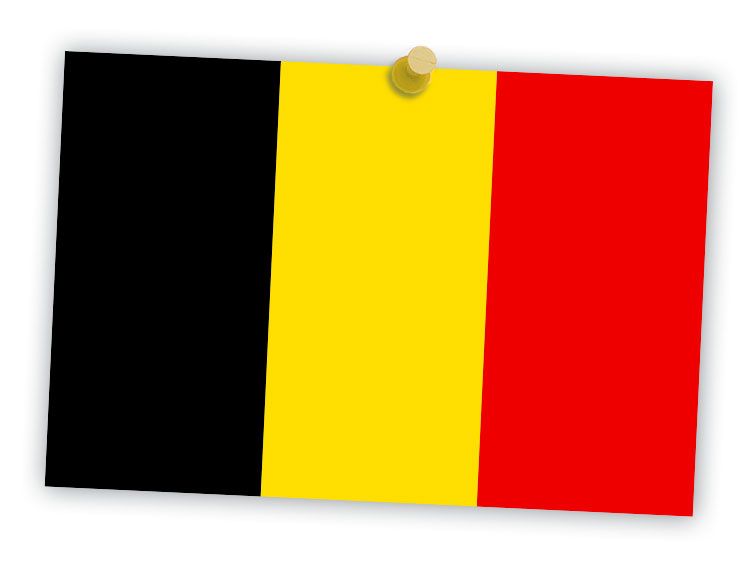
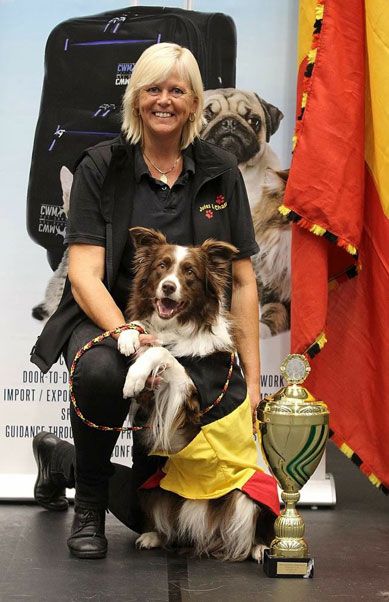
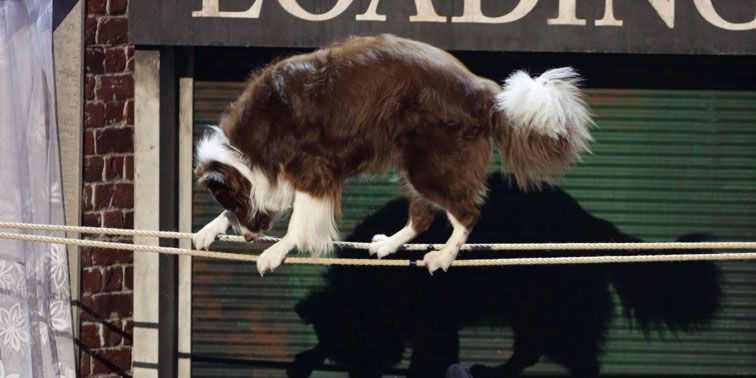
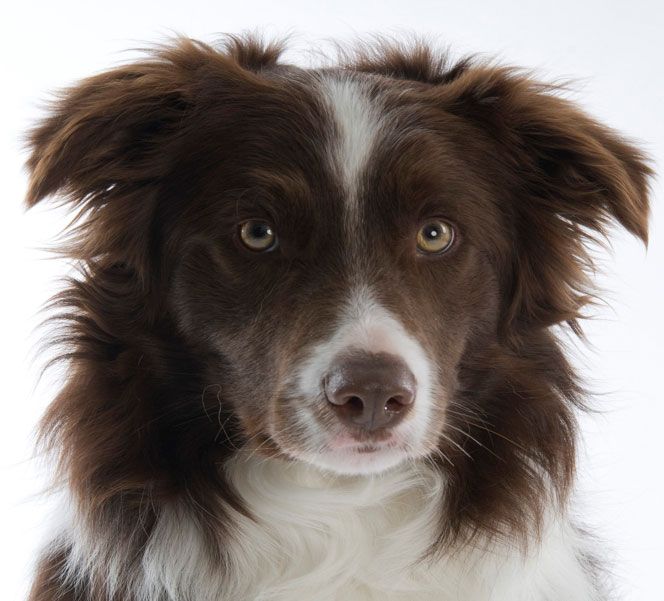
3.3
Savanne
Quand Yvonne m’a annoncé son intention de faire un cadeau de Noël à tous les propriétaires de chiens, à travers son merveilleux site, Alice-Ribbon Project – the Power of Love, j’ai été projeté en arrière :
À la veille d’un autre Noël, celui de 2004.
C’est à ce moment-là qu’a vu le jour le site www.obe-rythmee.fr (aujourd’hui défunt), qui avait pour vocation de répandre la «bonne nouvelle»: que l’éducation canine pourrait se faire par des méthodes douces, et que chien et maître pourraient devenir de vrais complices en faisant des chorégraphies sous fond musical.
Fast-forward jusqu’en 2015 :
Deux Tervuerens, Spike et Savanne, vivent ensemble. Leurs vies se sont mélangées, pour n’en faire qu’un.
Ils sont suivis par une excellente équipe de vétérinaires, à 10 minutes de la maison ou ils habitent.
Frère et sœur de portée, ils ont les mêmes origines génétiques. Mais ô combien de différences au niveau de leur santé !
Spike a eu un cancer testiculaire, heureusement dépisté à temps et soigné.
Savanne, n’ayant jamais eu de maladie grave, est foudroyé par un AVC, intervenu dans la nuit du 10 mai 2015, après une promenade où les voisins ont commenté « qu’elle avait l’air beaucoup plus en forme que son frère ».
Notre équipe habituel de vétérinaires l’ont accueilli d’urgence, une belle soirée de dimanche, à leur clinique.
Tout le long de la route, je pensais qu’elle allait rejoindre le « Big Sky », comme disent les indigènes des USA ; je me préparais au verdicte : l’euthanasie était indiquée.
Pourtant, on a décidé de faire des analyses de sang, donner des médicaments, etc.
Elle a survécu 4 jours.
Nos voisins se sont mobilisés pour l’aider, quand je ne pouvais pas être là. Elle voulait être dans le jardin - son bien-aimé jardin ! - mais on veillait à ce qu’elle ne reste pas trop au soleil…
Elle buvait uniquement à la syringe, on se relayait pour l’abreuver et marquer les doses d’eau qu’elle a consommé.
Ce qu’on a échangé, elle et moi, durant ses derniers jours, c’est difficile à décrire.
Mais je crois que c’était de l’amour, dans l’état pur.
Je me souviens d’une soirée, ou le vent rugissait dehors. Elle était sur son tapis, par terre, et j’ai amené un coussin de chaise longue pour passer la soirée auprès d’elle, allongée par terre moi aussi.
Faisant écho du vent, je criais tout fort ma peine et mon amour. Ma pauvre Savanne, je crois bien que tu as compris.
Après deux jours encore, il m’a fallu te laisser partir dans le « Big Sky ».
Est-ce que j’ai bien fait d’attendre ?
Spike
Spike, après avoir souffert d’un cancer de testicule (heureusement soigné à temps), a vécu heureux, jusqu’en septembre 2015. Quatre mois après la disparition de sa sœur.
Il présente des symptômes anormaux, surtout une perte de poids, bien qu’il mange normalement.
Le vétérinaire de mes deux chiens étant occupé ailleurs, j’ai eu une consultation avec un « nouveau » vétos qui m’a assené une diagnose fulgurante :
C’est probablement un cancer de l’estomac.
« Quoi ? » dis-je, « mais c’est pas possible ! »
« Bien sûr que si !», dis celui-ci, en m’étalant les informations auxquelles il a accès, mais pas moi.
À ce moment-là, le grand public n’était pas au courant de la tendance des Tervuerens à souffrir du cancer de l’estomac. Maintenant, il y a tout une page de Facebook sur le sujet.
Spike a été soigné. Son poids remontait.
Périodiquement, je passais au cabinet de mes vétos, pour le faire peser.
« Champion des poids-lourds ! » j’exclamais, chaque fois que son poids restait stable ou augmentait.
Mais « l’ennemi invisible », à l’intérieur de lui, restait invincible.
Il m’a offert un dernier Noël, celui de 2015, tout en chaleur et en beauté.
Il a tenu à m’accompagner jusqu’à mon départ en retraite, février 2016, toujours (apparemment) bien portant.
Au mois de mars, après un voyage en Angleterre, je le retrouve affaibli. Malgré les soins prodigués pendant mon absence.
Le 1 avril, j’ai dû me rendre à l’évidence. Il cherchait à rejoindre sa sœur, dans le « Big Sky ».
Comme elle, il ne jurait que par son jardin. Mais, il n’est pas parvenu à se relever pour y aller. Il m’adressait des regards de désespoir.
Maintenant, grâce au site d’Yvonne, je sais que j’aurais pu l’aider en mettant une serviette dessous lui, en guise d’harnais, car moi, je n’avais pas la force de le soulever du sol et le porter dans le jardin.
Là, j’ai compris qu’il fallait appeler au secours.
Lui faire partir au « Big Sky », mais depuis son jardin, qu’il aimait tant.
C’était un vendredi soir, les vétos habituels dans notre clinique étaient trop occupés.
Avec un désespoir grandissant, je me suis mise à téléphoner à tous les cliniques, privés ou autres, dans tous les alentours.
Pas un seul véto qui pourrait « se déplacer » pour faire de l’euthanasie à domicile ce soir-là.
Donc, mon pauvre Spike, j’ai du me résigner à trouver le moyen de t’amener à une autre ville, dans une autre clinique ou te ne connaissais personne, pour te faire les dernier soins de ta vie.
Merci, mille fois merci, à notre voisine, sensible amatrice d’animaux, qui a vu que j’avais « perdu mes moyens » et a alerté notre voisinage.
Merci, mille fois merci encore, au voisin, footballer costaud, qui a soulevé Spike d’un seul coup et l’a placé dans ma voiture.
Et merci à la clinique ou il a trouvé son soulagement.
Cette clinique, c’est dans un très bel endroit, avec vue sur le Jura.
Juste après la disparition de Spike, j’ai vu un oiseau s’envoler. En direction des montagnes.
Debra Bérnard


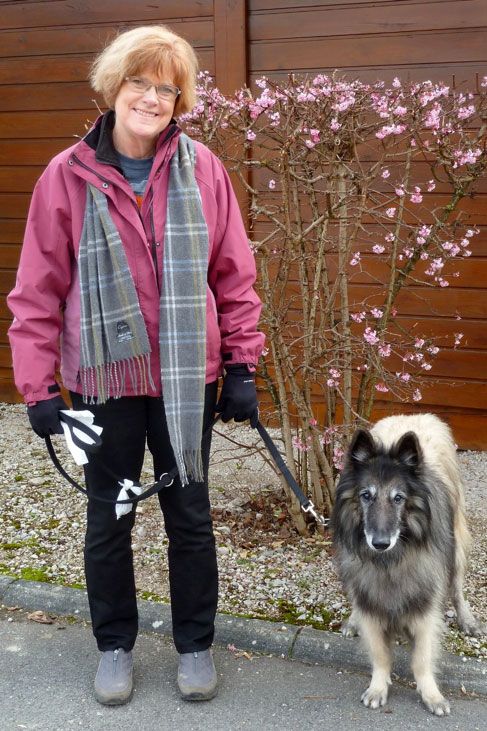
3.4
НатальяДжой - метис шар пея. Всегда жил активной жизнью. В 7 лет Джой начал заниматься танцами с собаками, через год вышел на соревнования. В 8 лет он побежал аджилити, а в 9 вышел на первые соревнования. Всегда был бодр и весел. В декабре 2014г Джой учавствовал в соревнованиях по танцам с собаками и был призером в 2х классах. И ничего не предвещало беды...
24.01.15 Джой был записан на соревнования, но не попал на них. Вечером 23.01.15 ему резко стало плохо. Температура упала до 35°. Мы поехали в клинику. Всю ночь он пролежал под капельницей и с обогревателем. К утру температуру подняли и нас отпустили домой. Так и не поставив диагноз. Днем мы поехали на узи в другую клинику. Там обнаружили жидкость в сердечной сумке и рекомендовали обратиться к кардиологу. Уже вечером мы попали к кардиологу, который подтвердил наличае жидкости, но сказал, т.к. собаке сейчас лучше, то трогать его не стоит. Немного успокоившись, мы вернулись домой. Дальше было 2 дня затишья.
26.01 Джой погулял, поел и я собиралась на работу. Я уже шла к выходу и услышала, что дыхание собаки поменялось... Я к нему. Температура падает. Мы ждем такси. Когда пришло такси Джой еле шел. Из машины в клинику я уже несла его на руках. Когда нас приняли, он был почти холодный... его положили на стол, включили аппарат узи и сообщили, что у Джоя опухоль на сердце, которая давит на аорту и от этого произошло кровоизлияние. Если жидкость не откачать сейчас - он умрет, но и при откачивании жидкости он может умереть в любой момент... Я приняла решение бороться и пытаться откачать. Кровь откачали и сказали, что следующий час будет решающим. Через час Джой пошел сам! Дальше врачами было предложено несколько вариантов: операция, удаление опухоли на сердце; лечение у анколога и химиятерапия; усыпление... Врачи говорили, что рецедив наступит скоро и второй откачки он не переживет, что скорее всего осталось несколько месяцев...
На тот момент Джою было почти 11 лет. Я понимала что, даже если я найду кардиохирурга, собака может просто не пережить операцию. Я обзвонила всех знакомых ветеринаров... Выслушала кучу мнений... От не трогай собаку, гуляй спокойно на поводке, до не мучай - усыпи. Решение было сделать очень тяжело... Я решила, что сделаю все чтобы то время, которое осталось, моя собака будет активной и будет радоваться жизни, даже если осталось совсем чуть чуть! Я стала уговаривать его поесть за команды - он начал есть и глаза начали оживать! Через неделю он начал играть! Я радовалась каждому дню, когда он вилял хвостом, а глаза его загорались! Через пару месяцев внешне не было и следа... Дальше собака естественно перестала выступать. Но он так же получал хороший выгул и щадящие занятия для развлечения. Профилактически я где то раз в пару месяцев посещала врачей, которые следили за состоянием опухоли и сердца. Они говорили, что Джой уникальная собака... Опухоль медленно, но увеличивалась.
С момента обнаружения опухоли, вопреки врачам, Джоик живет и радуется жизни! Сейчас ему 14.5 и он уже имеет 2 опухоли на сердце и 1 на селизенке. Одна опухольна сердце давит на трахею, Джой кашляет и тяжело дышит. Для облегчения дыхание, я делаю ингалации бекламетазона, а в моменты обострения он получает курс преднезалона. И он, несмотря ни на что, живет!!! В свои 14.5 он поекрасно гуляет по 40 минут, он с удовольствием занимается. Да он уже плохо видит, он иногда сильно кашляет, но он живет! И мы поставили цель докашлять до 15 лет!
Here the translation of Nathalia's touching cancer-story - with a hopeful and happy ending:
Joy is a half-breed Shar-Pei. We always had an active life together. At the age of 7, Joy started dog dance training, a year later he already entered the first competition. At the age of 8 he started to run agility, and at 9 he run his first competition. He has always been motivated and cheerful. In December 2014, Joy participated his last dog dance competition and won the first place in 2 classes. And nothing foreshadowed troubles...
On 24th January 2015, Joy was registered to participate at a competition. However, he didn’t perform as usually. On the evening of 25th January 2015, he suddenly became very ill. The temperature dropped to 35 °! We immediately went to a veterinary clinic. All night he was placed under a heater to raise his temperature and was drip-fed. By the morning, fortunately the temperature had raised and we were allowed to go home - without making any further examinations or screening. In the afternoon, however, I decided to have an ultrasound examination made at another clinic. And - they found liquid in a cardiac chamber and recommended to see a cardiologist without delay. The same evening we went to a cardiologist, who confirmed the presence of fluid, but recommended not to undertake any further treatments since the dog’s condition seemed better in the meantime. I was reassured and we finally returned home. The next 2 days Joy was calm and seemed all right.
The next day, Joy had a short walk, ate with appetite, and I was going to go to work. I was already half-way out of the door when I heard that the dog’s respiratory rate had changed ... I went back to him and discovered that the temperature had dropped again. I called a taxi and by the time the taxi had arrived, Joy couldn’t walk. I had to carry Joy in my arms from the taxi to the clinic. When they received us, he was almost completely cold ... they put him on a table, made an ultrasound picture and found out that Joy had a tumour on the heart, which was pressing on the aorta. This caused a life-threatening haemorrhage. If the liquid wasn’t pumped out immediately, he would die. On the other hand, so the doctor said, the he might also succumb during the intervention.... I decided to fight and have the liquid pumped out. The doctor said that the following hour would be decisive. By miracle, an hour later, Joy could walk by himself again!
Subsequently the doctors suggested several options: 1) surgery: removal of the tumour on the heart, 2) treatment by an oncologist and chemotherapy, 3) euthanasia... The doctors warned that Joy would most probably have a relapse sooner or later and that he would not survive a second pumping-intervention. In other words, that Joy most likely only had a couple of months left to live...
At that time, Joy was almost 11 years old. I understood that even if I found a cardiac surgeon, Joy may not survive the surgery. I phoned all veterinarians I knew ... I listened to different opinions ... From 1) do not touch the dog, 2) walk calmly on a leash, 3) do not torture him, 4) relieve him with euthanasia. The decision was very hard to take ... I decided that I would do everything to make Joy’s remaining life time as active and enjoyable as possible, however short the time might be!
With a lot of tricks, I persuade him to eat – and, he began to eat and his eyes began to revive! Only a week later, he began to play again! It made me so immensely happy to see him wagging his tail with his eyes lit up! After a couple of months, he just looked like a normal and healthy dog... But, of course, Joy wasn’t able to perform as before. But we still enjoyed extensive walks together and light training activities for fun.
As a precaution, I had an appointment at a veterinary once a month, who monitored the state of the tumour and the heart. He said that Joy was a unique dog ... The tumour was growing, but only very slowly.
Contrary to the initial opinion and prediction of the veterinarians, Joy leads a happy and active life - despite his carcinoid tumour! He is now 14.5 and has already developed two tumours on his heart and one on his spleen. One tumour on his heart presses on the trachea (air tube), which makes Joy cough and breathe heavily. To help him breath easier, I use inhalation of beclomethasone, and when his state of health gets critical and his cough gets persistent, he receives a cure of prednezalone (cortison). And, in spite of all difficulties, HE LIVES AND IS HAPPY AS CAN BE !!! At 14.5, he has his daily walks of 40 minutes and he enjoys playing and doing is light training sessions.
And we have set a goal to live to at least 15 years!

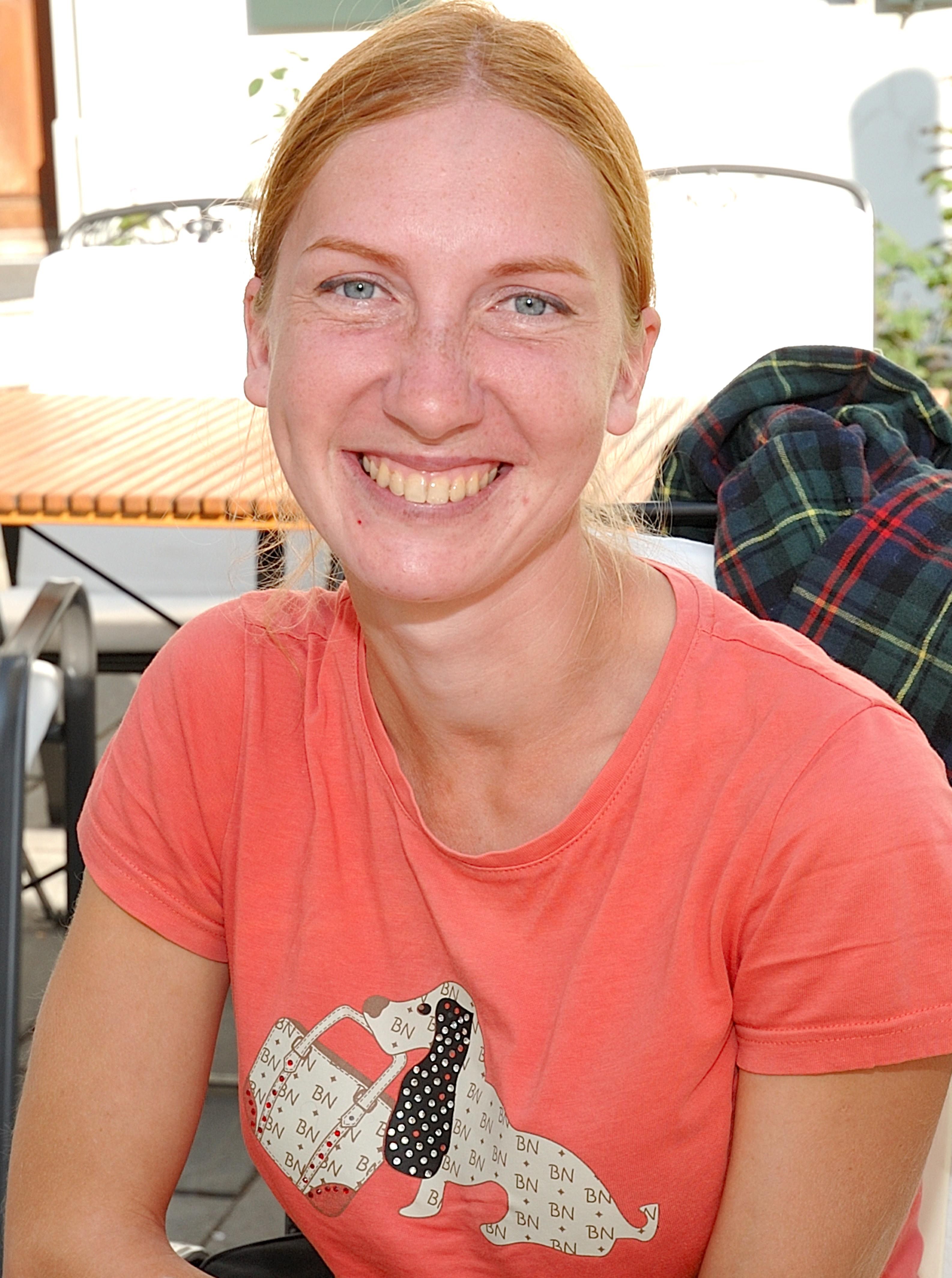


3.5
Fly’s Story
Hemangiosarcoma
Iatka Spring Spangle was her Kennel Club name but to us she was our little Fly. Born on April Fool’s Day 1/4/2001 but she was no fool. Clever, honest, enthusiastic, wanting to live life at a thousand miles an hour and loving every second!
Many people will remember Fly from her appearances at Crufts, winning the Heelwork to Music Final in 2008 and taking 2nd place in 2013. She was placed highly in the top 10 every year from the inaugural HTM Final at Crufts in 2006 and throughout her life, never missing a year. To our delight she went on to win the first ever Open European Championships which was held in Denmark in 2011. Fly was selected for Team GB every year that they competed at subsequent OECs.
Sadly she was never to defend her European Title due to hemangiosarcoma.
2013 was proving a great year in competition with a second place at Crufts and the OEC to look forward to later in the year. This was the first opportunity that we had to defend her title and we were putting a lot of time into ensuring that we had the best chance.
One morning in early September I noticed a lump on her right foreleg, it was perfectly round and the size of a large pea. We saw the vet that same day, the lump was aspirated and a small amount of fluid was collected. On analysis we discovered that it was hemangiosarcoma. At the time I understood the seriousness of the diagnosis but was hopeful that we had caught it quickly enough.
Before we booked the surgery the vet made me aware of the potential size of the wound and the length of time that it would take to heal. It was not long before we were due to travel to the OEC and I was given the option to have the surgery on our return home as the wound would not be healed in time to travel to The Netherlands. Wait? NO WAY! Any delay meant a greater chance of the disease spreading and there wasn’t a rosette or title in the world that was worth more than the health of any of my dogs!
From first discovery of the lump to the removal of the tumour was less than a week. We observed and palpated her lymph nodes to check for any obvious spread of the disease before surgery and made sure to take wide margins from the site. This left a large wound, too large to close with stitches and so we had to achieve the healing process with regular dressing management.
Fly was the perfect patient throughout the procedure and all of the follow up treatment. The regular dressing changes were uncomfortable for her but her behaviour was nothing short of excellent. A couple of weeks later I left for the Netherlands with Erin (Team GB Freestyle Reserve) and Allan stayed home to continue Fly’s dressing treatment.
The wound healed very well and it was a relief to us all when it could be left open to the air with no more bandages to change or boots to be worn when going outside. We decided not to take the option of further treatment and continued to make the most of every day that we had left with our special girl.
Fly was very keen to get back into training, she had missed it terribly. We returned to the routine that we had been working on for Crufts 2014 but it soon became clear that we had lost a lot of training time and the routine was very demanding and complicated, we would not be able to do it justice. We made the decision to use a simpler piece of music with less challenging moves and just enjoy our time together in the ring. In January we qualified for the Crufts Finals and at Crufts 2014, at the age of 13 Fly came 10th. I don’t think anyone has ever been happier with last place! A great achievement; I was so proud of her and so happy to still be able to enjoy life with her.
We had 2 more wonderful years together after her surgery and made lots more memories. Although she was selected for Team GB 2014 we bowed out gracefully when I realised that her hearing and was failing and we couldn’t achieve the standard that we had previously enjoyed. It was good to see our reserve dog do so well in our place and I still enjoyed the trip to Germany supporting our Team as HTM Team Leader.
Fly continued to enjoy her dance training of course and if she did an incorrect move she was never wrong – it was my fault for not speaking loudly and clearly, I could tell that by the look on her face, I was wrong and she was right, just as it should be J
We finally said goodbye to Fly at the beginning of 2016. I don’t need to explain to anyone who has lost a dog how that felt, she took a little piece of my heart with her. I am eternally grateful for the extra time that we had with Fly following diagnosis, I know that there are many who are not so lucky and my thoughts are with them as I write this.
Fly is always with me, in my heart and in her precious ashes contained in my necklace.
Karen Sykes

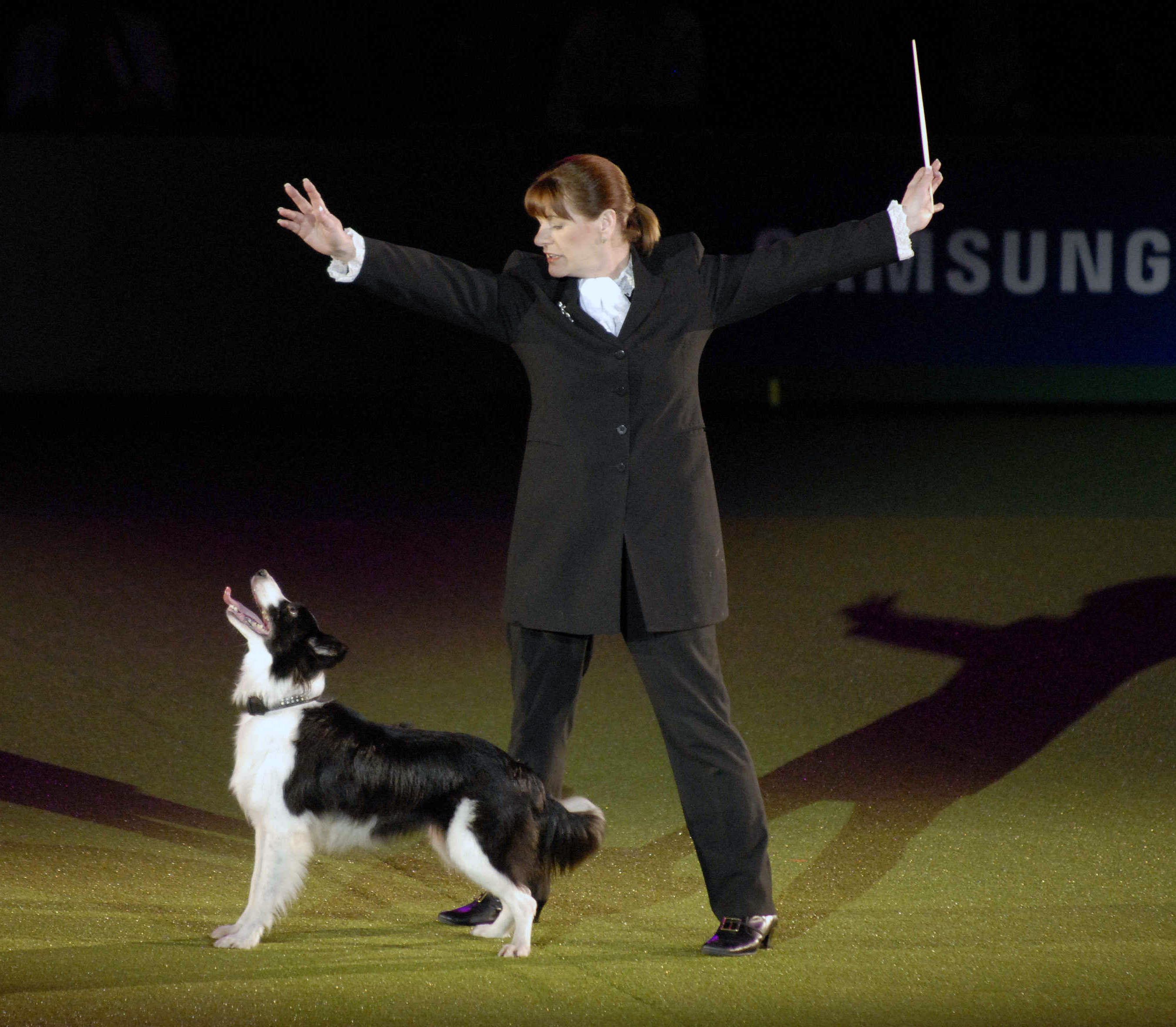
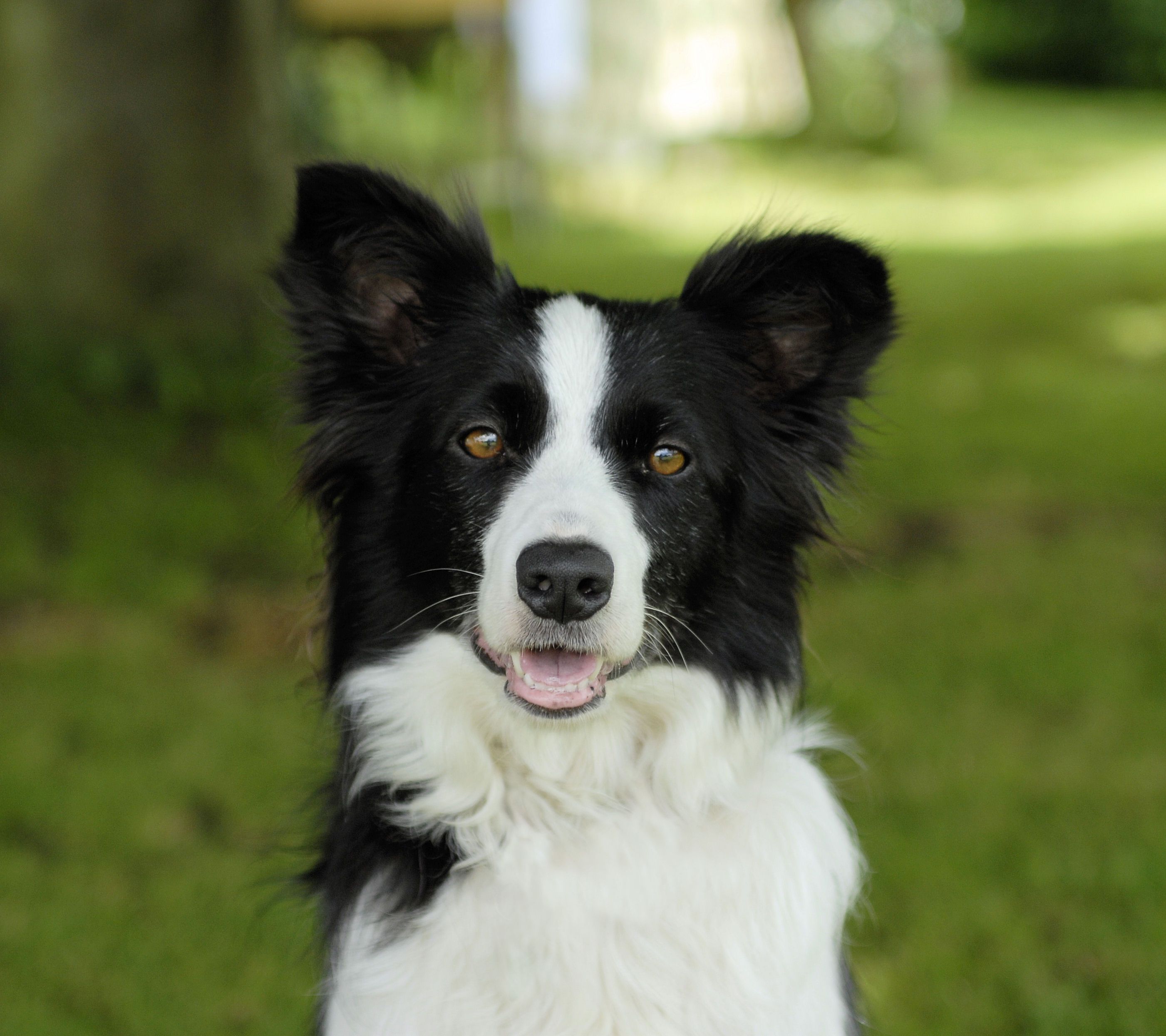
3.6
My Shmy (Australian Shepherd) passed away for more than two years now, and I still cannot forget how, after she was diagnosed with cancer, we tossed from despair to hope: it was impossible to realize that we are powerless when faced with this terrible diagnosis: Cancer. Losing dogs is very difficult! Losing a young dog, still full of strength and life, is simply unbearable
People say that time heals, but I really miss him so much still
Yvonne asked me to write an article about my Shmy’s cancer story, in order to make him an Ambassador for her “The Alice-Ribbon” internet link in favour of canine cancer awareness. It is a very necessary and important task and I promised her to help to promote this site among as many dog owner’s as possible to allow our dogs a dignified life before and during a cancer diagnosis and an equally dignified end of life!
I also tried to write a sad history of Shmu's illness, but I'm not good at it: it just hurts so much!
She was ill for exactly one month. It all began with a slight limping of the hind legs in the turns, and I suspected that it was an unsuccessful jump that had caused an injury in the back. However, medical examinations of her back did not confirm this suspicion. Worse, a blood test made by the veterinarian showed results of a suspected lymphoma (blood cancer). 10 days later, Shmu had a first epileptic fit. A MRI-screening showed multiple sites of inflammation in the brain and the veterinarian now suspected a generalized brain tumor and we immediately started radio-therapy. But the treatment indicated after such diagnosis did not work. Shmu stopped moving his tail, then became blind, when it became clear that nothing was working, and the painkillers were not working anymore, I let her go….
My dog had died from cancer, a very fast and aggressive form. We could not do anything
I cannot believe that she is no longer with me
Olga Kuzina



3.7.
Лола 07.03.2013-14.10.2017
Лола прожила короткую, но яркую жизнь: Лола занималась танцами и участвовала в соревнованиях, путешествовала по 7 странам, снималась у Валерии Гай Германики в короткометражном фильме «Фильм о любви, снятый собаками» и в «Живых историях» с Иваном Затевахиным (выпуск от 25.11.2017г.).
Предыстория
Лола - моя вторая собака. Моя первая собака Бусинка осталась жить с родителями. И на тот момент, когда я решила завести собаку себе, то Бусе было уже более 10 лет, и она была частым посетителем ветклиник в силу своего возраста, а до стерилизации еще и обладателем мучительных ложных беременностей. С новой собакой же хотелось минимизировать риск проблем со здоровьем. Поэтому выбирая среди заводчиков я остановилась на питомнике, в котором очень тщательно подходят к проверке здоровья – собаки проверяются на дисплазию, проверяют зрение и слух, производители проходят все доступные генетические исследования. И ни у кого из собак питомника не было случаев ложной беременности или онкологии. Немного настораживал инбридинг в родословной, но это меня не остановило от покупки.
И вот, наконец, мы забираем трехмесячную Лолу домой. Она нервничает из-за переезда, какает в машине, а затем и ночью ее пропоносит на дверь и пол в коридоре. Мы вместе с заводчиком думаем, что стул нарушился из-за стресса и даем пробиотики, после которых все нормализуется. В будущем мы еще не один раз будем давать разные комбинации пробиотиков, а энтерофурил и энтеросгель станут нашими вечными спутниками.
В своем яром желании иметь здоровую собаку уже в 4 месяца мы получили рвоту глистами, в 6 месяцев перелом пятки при травме, в 7.5 месяцев – повторный перелом этой же пятки. Было проведено две операции, и было решено оставить спицы в лапе.
Лапа вскоре зажила и никаких проблем (разве что стертая подушечка после долгой прогулки) более не доставляла. А в год на зубах уже появился зубной камень, который пришлось чистить ультразвуком. Я заподозрила проблемы с пищеварением, но плановое УЗИ не выявило никаких проблем с пищеварением, показало лишь увеличение селезенки, а заводчики заверили, что у большинства бобтейлов находят спленомегалию, и это норма. Но нарушения стула же периодически возникали от съеденной гипсовой штукатурки с откоса, резиночки с шерсти, или от вылизанной и съеденной шерсти во время течки (а течка была дважды-трижды в год) или, как мне казалось, от того, что собаку родственники угостили кусочком со стола. Потом, понаблюдав за остальными собаками, я поняла, что от маленького кусочка сыра или хлеба у здоровой тридцатипятикиллограммовой собаки никаких последствий не возникает. На память об этих проблемах фотограф из поездки с ДОСААФ на показательные выступления запечатлел кучку на асфальте перед ротондой на главной аллее в крымской Николаевке. В этот период была комбинация: жары, переезда, течки и купленной в местном магазине неизвестной сосиски для лакомства за выступление. Конфуз был списан на некачественную сосиску, хотя мы были не единственными из выступающих, кто употребил те же самые сосиски, только без последствий. Лоле на тот момент было 2.5 года. В течение полугода, до весны больше ничего не беспокоило.
Наступила весна и нужно было защищаться от клещей. От капель у Лолы всегда было не очень хорошее самочувствие в день обработки. И мы решили попробовать не капли, а таблетки. Тем более, что все лолины родственники их уже принимали, и побочных эффектов не было. У Лолы же почти сразу после приема начались ужасные проблемы со стулом. Анализы мочи, крови и кала никаких отклонений, кроме наличия небольшого количества цитоизоспор в кале не выявили. В итоге началось лечение от цитоизоспороза. Лечение длилось более месяца, и препараты купировали все негативные симптомы.
Прошло четыре месяца, а, значит, пришло время обрабатывать от клещей перед осенним пиком их атаки. Снова таблетка от клещей, и снова те же симптомы, снова лечение. К концу осени все наладилось. Мы сдали анализы мочи/кала/крови, которые показали, что все в порядке.
В декабре Лола сдала кровь как донор (прежде у нее, конечно же, проверили показатели крови, и все было в порядке), без седации, а самочувствие после сдачи было прекрасное.
Первые симптомы
Наступил июль и мой декретный отпуск. Мы продолжали тренировки как обычно, много гуляли, ничего необычного в поведении Лолы не было. Даже съездили на показательные выступления. Лола быстро устала (как мне показалось, что быстрее обычного), но на улице в тот день было жарко. В конце июля на Лолу несколько раз пытались напасть собаки, и после этого она стала вести себя на улице подозрительно, могла рычать на незнакомых собак, или отказывалась идти в ту сторону, где на нее напал далматин. Беременной мне оттаскивать собаку чужую собаку было не очень легко, поэтому мы стали ходить гулять в компании знакомых собак, так мы чувствовали себя увереннее.
Наступил август, самый жаркий летний месяц, и пришла запоздавшая на несколько месяцев течка. В жару мне стало сложно было гулять в привычном графике, мы гуляли теперь меньше по времени. Наш режим дня изменился и теперь по утрам мы с Лолой могли долго спать. Я была удивлена, что Лола, как обычно, не просится на прогулку рано утром, но подумала, что она жалеет свою беременную хозяйку. Почти все жаркое время мы лежали дома то под кондиционером, то с распахнутыми окнами. Однажды в такое распахнутое окно задуло ветром грачонка, грачонок приземлился прямо на Лолу. Говорят, птица в доме – плохая примета. Но мы не верим в приметы.
16.08.17- были запланированы съемки в «Живых историях» с Иваном Затевахиным. То, как мы отработали, можно посмотреть в выпуске программы от 25.11.2017. Лола была очень весела и радостна. Помимо домашнего лакомства Лолу там угостили собачьим лакомством из упаковки, которое мы еще ни разу не пробовали. На следующий день Лолу вырвало и она отказалась от утренней порции еды. Я предположила, что перекормила лакомствами на съемках. Рвота более не повторялась, но аппетит ухудшился. Лола стала отказываться от сухого корма, но при этом есть арбуз и мясные субпродукты. Или могла съесть сухой корм, если в него подмешана сметана. Списали это на жару и капризы. Потом Лола съела кусок гипсокартона, который уже два месяца лежал в квартире и не вызывал у нее интереса. Начались проблемы со стулом, тягой к поеданию травы на улице и такой же плохой аппетит.
Постановка диагноза
07.09.17 - Мы поехали на диагностику к тому же самому специалисту, который делал то единственное «плановое» УЗИ. Получили заключение: «объемное образование печени, признаки панкреатита, нельзя исключить неоплазии поджелудочной железы. Мезаденит. Неоплазия лимфоузлов?». Потом мы уже дома сравнили предыдущее УЗИ и увидели, что на предыдущем УЗИ вообще ничего не написано про поджелудочную. Забыли тогда про нее написать или забыли тогда ее посмотреть? Вдруг и тогда что-то уже было? Все анализы крови, что были сданы ранее – тоже не включают показатели печени и поджелудочной.
08.09.17 Едем к онкологу Серовой. Заказываем экспресс-тест крови на необходимые показатели - по результатам анализа крови есть только небольшие отклонения. Делаем рентген груди – метастаз в груди не видно, но лимфоузлы увеличены. Есть несколько вариантов диагнозов – первичная опухоль в поджелудочной или лимфома. Назначена операция в срочном внеочередном порядке.
09.09.17 Едем к онкологу Белоусовой, чтобы услышать второе мнение. Она видит мягкий живот, без признаков болезненности, активную собаку. С операцией не торопит, относительно онкологии видит сомнения.
11.09.17 операция у Серовой– для диагностики и гистологии. При возможности хирурги должны были вырезать опухоль. Такой возможности не оказалось, поэтому операция была только диагностической (бонусом была удалена лишняя жидкость из брюшины). Вердикт – если химия не поможет, то жить собаке около месяца. И собака уже мучается, но виду не подает, потому что такой темперамент. Лола после операции еще несколько дней ест сама.
19.09.17 Мы начинаем химиотерапию до результатов гистологии, так как по результатам операции врачи понимают, что первичная опухоль в поджелудочной. Еда теперь дается только принудительно. На пятый день Лола заинтересовалась лакомством – собачьим печеньем и костью из жил. Но это последнее, что она ела сама. Спустя две недели после операции получаем результаты гистологии – недифференцированный рак поджелудочной железы (вероятно, аденокарцинома), метастазы в печень.
26.09.17 Лола уже не ест сама, принимает противорвотные препараты, еда заталкивается принудительно. От запаха еды ее тошнит и рвет. Внутривенно вводятся витамины и аминокислоты, гептрал, рингер лок, омез. Сами же ставим все необходимые уколы – мексидол, цефтриаксон, преднизолон, эпокрин. Даем таблетки катадолон, железо. Из-за развившейся анемии химиотерапию проводить нельзя.
03.10.17 Противорвотные перестают помогать при максимальной дозировке, часть принудительно скормленного выходит обратно. Вся семья старается есть еду без запаха и ничего не разогревать. Вставать на скользком полу становится все сложнее, Лола сильно похудела, а живот стал в несколько раз больше от опухоли и лишней жидкости. Мы мучаемся вопросом – мучается ли собака от боли? Но живот мягкий, и Лола не подает виду, что у нее что-то болит. Несмотря на все, Лола продолжает радоваться, когда кто-то приходит домой, виляет хвостом. Выполняет команду «дай лапу».
Лола продолжает ходить гулять на улицу для справления нужды. Когда гуляю с ней я, то на обратном пути она ложится на улице или в подъезде и не хочет идти домой. Поднять ее не могу, уговоры не помогают – я даже однажды попросила приглядеть за ней консьержку, пока ходила за теплым пледом, чтобы подстелить его на пол. Когда приезжает муж, то говорит «Лола, вставай», и Лола идет домой. Я где-то читала, что у собак есть инстинкт уходить умирать подальше от стаи, и вот такое поведение очень похоже на следование этом инстинкту.
Катетер, который приходится менять каждые 5 дней, а то и чаще, теперь могут поставить только виртуозы из-за состояния вен.
12.10.17 Анемия достигает пика, мы решаем сделать переливание крови, хоть никто из врачей и не рекомендует. Переливание оказывается небыстрым занятием, в общей сложности около 8 часов. Из-за градусника, которым периодически измеряют температуру, Лоле чаще обычного хотелось «в туалет», что еще больше удлиняло процесс.
Переливание завершилось успешно, очень необычно было снова увидеть красные десны. Как показалось, Лола слегка повеселела.
13.10.17 Носик у Лолы треснул посередине очень давно, но в этот день на носу я увидела кровь. Я подумала, что это кровь из трещины. От запаха крови Лолу затошнило, и она, как уже обычно при тошноте, на подкашивающихся лапах забегала туда-сюда. Сегодня она уже ничего не ела, только инфузионно.
14.10.2017
Вставать все труднее, если раньше не получалось на скользком, то сейчас уже и с лежанки вставать трудно. Вид у Лолы был очень подавленный. Лола суетилась в коридоре, мы думали, что из-за тошноты, но оказалось, что хотела в туалет и сходила под себя на лежанку. Позже ее вырвало кусочками еды, которые она ела несколько дней назад, все было непереваренное и гниющее. На носу опять проступила кровь. Но в этот раз мы уже увидели, что кровь идет из носа, из глубины. И накапало с небольшую лужицу.
В этот момент мы приняли решение, что паллиативная помощь уже будет во вред, а не во благо. Мы сказали Лоле «Пойдем гулять!», помогли ей встать, а Лола сама смогла выйти на улицу, дойти до машины, попыталась сама в нее залезть. Она понимала, что идет не гулять…
Хоть Лола и не выиграла в схватке с болезнью, она – настоящий борец.
Evgeniya Lazarova

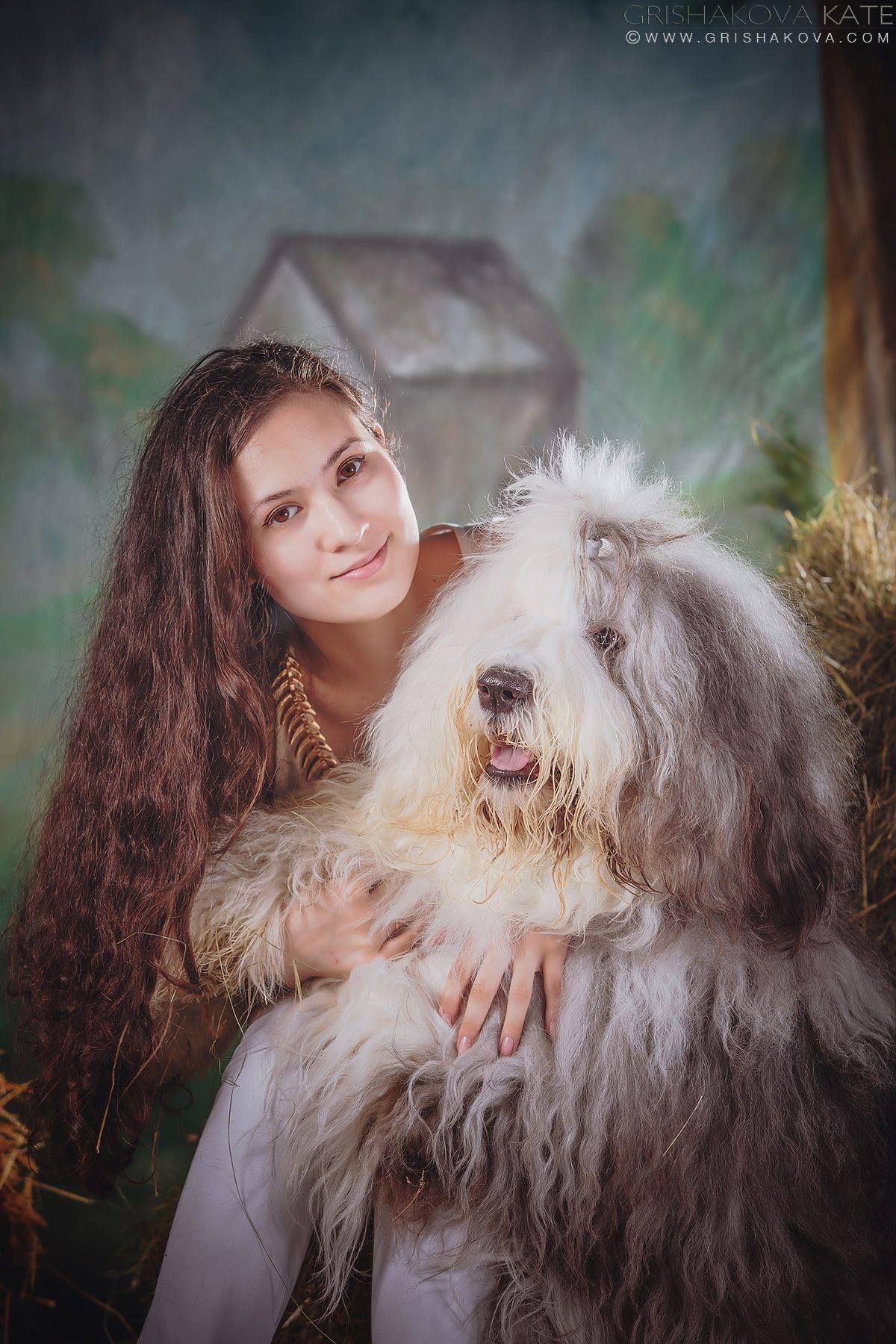
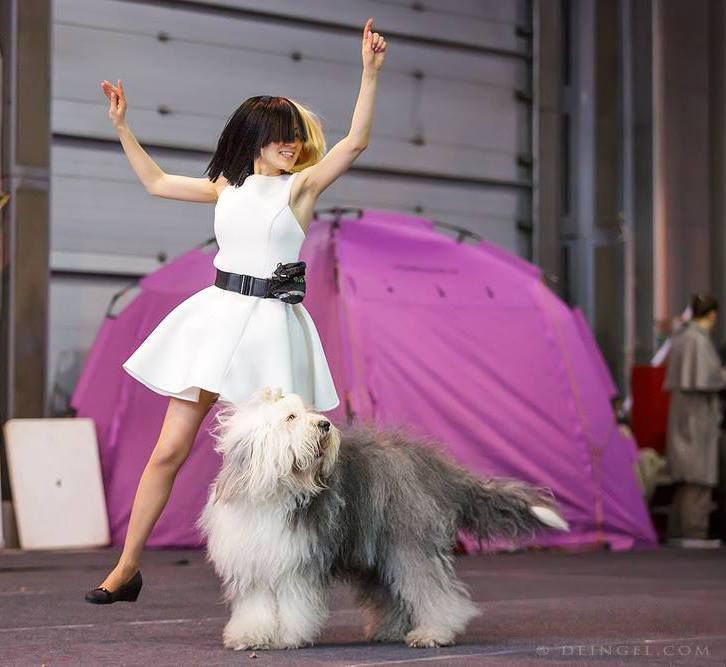
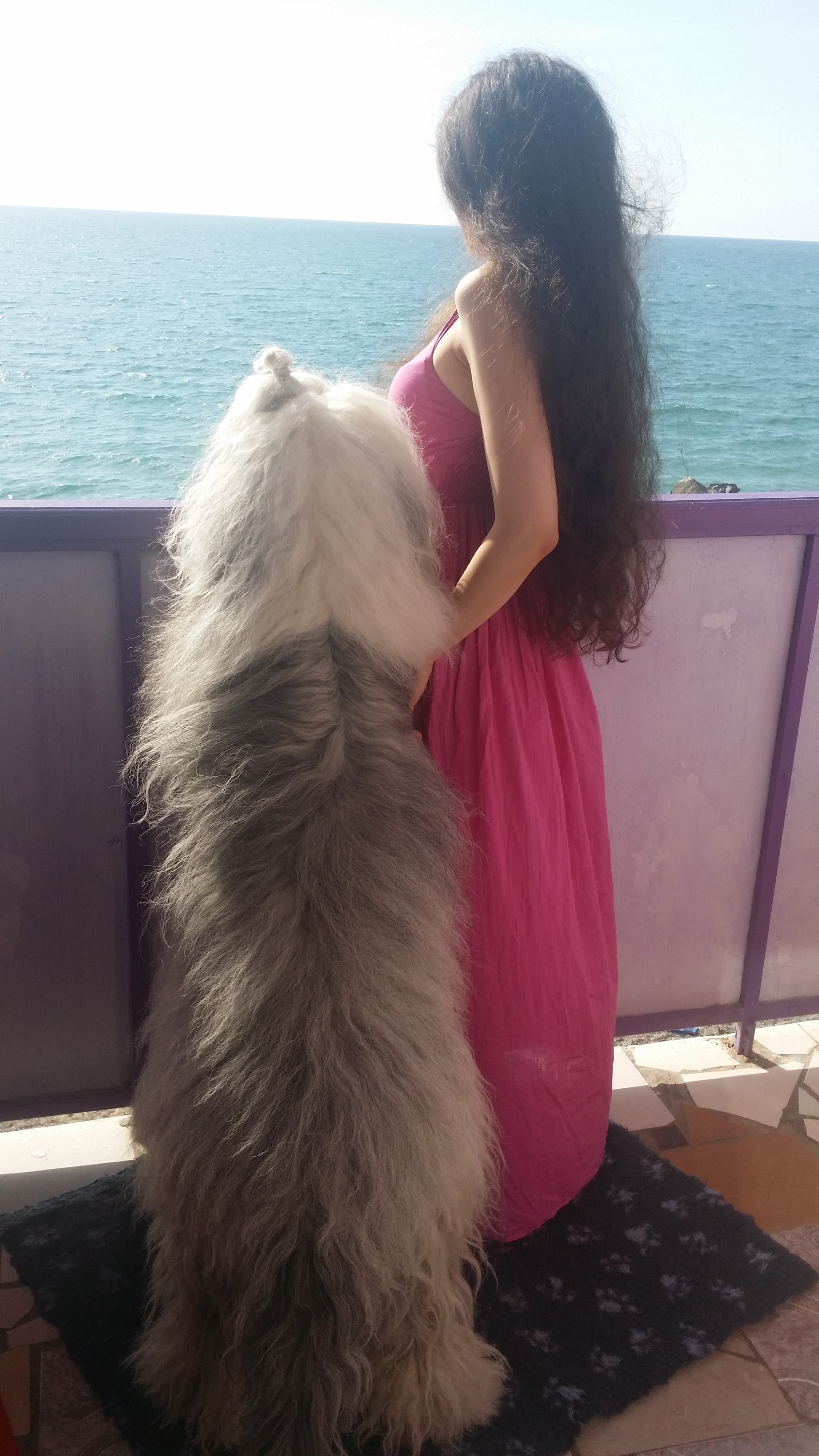
3.8.
My Sweet Listo (September 23, 2003 – September 6, 2014) by Michele Pouliot
When I named my new Australian Shepherd puppy “Listo” little did I foresee how fitting the name would be for him. Listo is Spanish for “I’m Ready”. Basically, he was always “Ready”.
September 6, 2014: A 10-year-old Listo had just recently retired from competition but was still enjoying his daily training sessions. Listo had made a name for himself in the canine freestyle world, being my exceptional performance partner for 7 years. Not just a great performer, Listo was truly a great actor and could make an audience laugh, smile and cry. He was my dear friend and partner in the creation of our “freestyle art”. On many an occasion, Listo made me look better than I was.
Listo truly made every performance special. He loved to perform.
Early in 2014, I made the decision to retire Listo due to his increasing hearing loss which made it difficult for him to hear me in the performance environments. Physically, he had not changed much as a senior. He remained high energy and always ready to clicker train.
The evening of September 5, 2014 we had a very cool training session. Listo was having tons of fun offering behaviors for me and basically showing off to my other 2 dogs. That evening, I was finishing up invitations for an 11th birthday party for Listo (his birthday just a few weeks away).
I was up early on the morning of September 6, 2014, to drive 2 hours to a facility where I would give private lessons all day. Listo did not finish his breakfast (very odd) but was otherwise acting normal. I decided to leave him home with my husband to keep an eye on him. I also left Deja, my springer, at home with Listo for company. I only took my year-old Aussie, Sake, with me for the day.
At my lunch break, I spoke with my husband and he felt Listo was sleeping more than normal but didn’t notice anything else unusual.
Upon arriving home, I quickly went to find Listo and see how he was acting. My husband was out on our acreage feeding the horses. Deja greeted me at the door, but no Listo. I found him downstairs lying on a dog bed. He was alert but the way he was lying was not normal. As I talked to him and approached, he lifted his head but did not get up.
This was the moment I knew something was very wrong.
Like the sweet boy he always was, Listo responded to my request for him to get up and come outside with me. He had trouble getting up, but he managed it and slowly followed me out to the back yard (just a few yards walk). The moment we reached the grass, he looked up at me and went down. As I stroked him, I felt how hard and large his belly was, and I knew……….
It was about 6 pm on a Saturday night. My adrenaline made it easy to carry Listo to the car. I called my husband back to the house and called the emergency clinic to prepare them for our arrival. We raced to the clinic (6 miles away) with Listo on my lap. He was, as always, the perfect gentleman and bravely acted as though he was just fine.
As we pulled up to the clinic, staff were waiting with a wheeled gurney. Within minutes Listo was with the internal specialist vet. As we waited, I relived the last day with one of my Labradors, in 2003, who passed suddenly from Hemangiosarcoma just before Listo was born. The similarities were distressing. Sadly, I was right.
It was Hemangiosarcoma.
Listo’s spleen had ruptured and he was bleeding out internally. Nothing could be done except to ease his pain.
This awful disease was taking another beloved family member. Once Listo’s pain was mitigated, I lay next to him on the mattress for quite a while, saying goodbye. Soon he was dozing, and I let my sweet Listo go.
Michele Pouliot

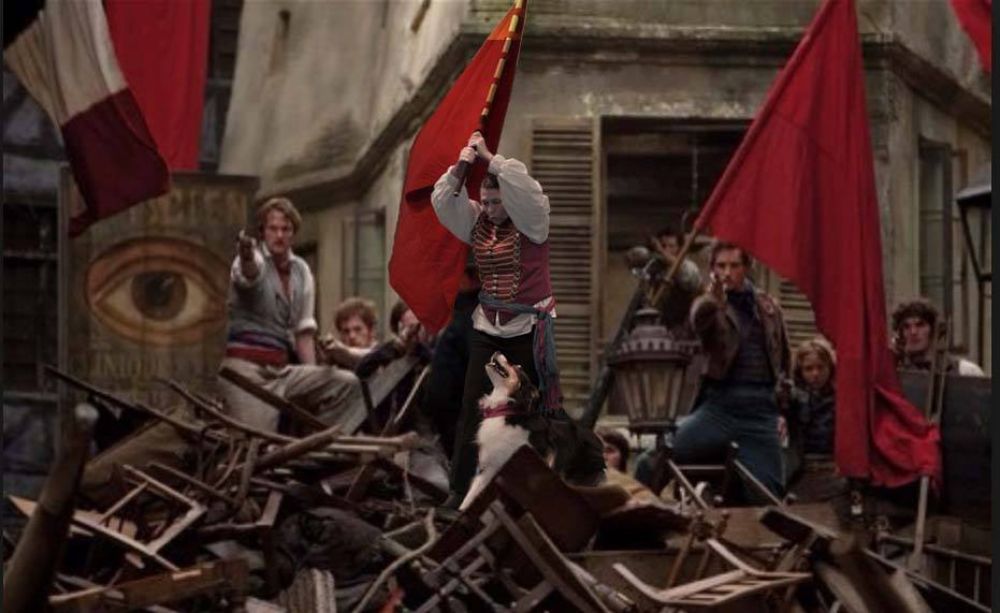
Our last routine together. We performed to Do You Hear the People Sing, from Les Miserables.
Listo was an incredible performer.
Photo by Dick Capello
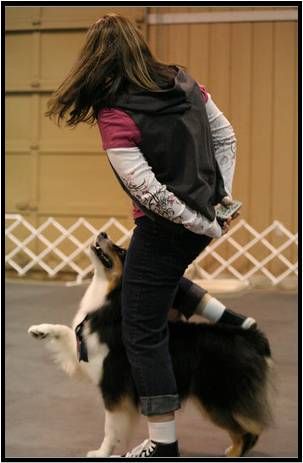
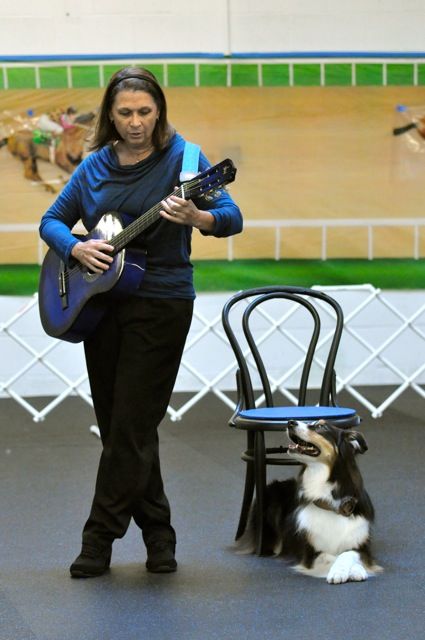
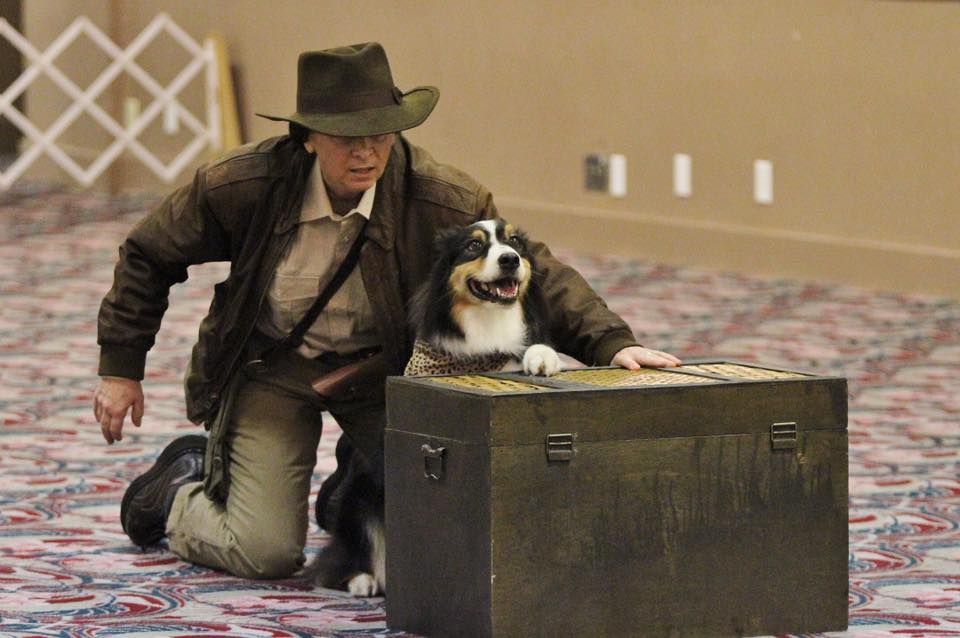
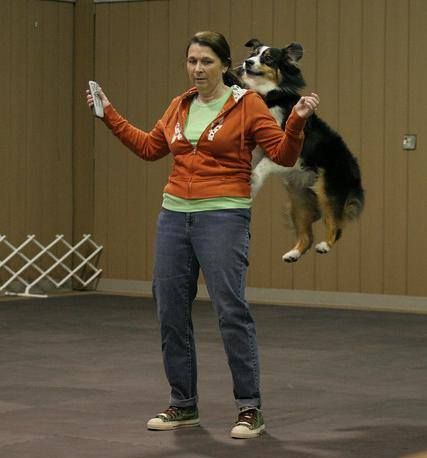
3.9
Cinnamon the Dancing Beagle
Kenalis Butterscotch Dream CGCF RA AD JD R-FE/CH Vet MF/X TEAM2
30 July 2007 ~ 23 July 2019
When I'm writing this text, three weeks will have passed after Cinnamon left us, and I still cannot believe that she is not with us anymore. It was just too sudden.
Cinnamon was my second dog and second Beagle. From the early puppyhood she was very responsive and agile, which made me want to try Agility with her, ignoring the general perception at that time that Beagles were hard to train. However, after participating in four competitions, she was diagnosed with Hip Dysplasia. So, I decided to retire her from Agility and started doing Dog Dancing instead.
As soon as we started learning Dog Dancing, both Cinnamon and I were hooked. In 2011 and 2013 we became the New Zealand National Champion by earning the highest score in the whole national competition. In 2013 we also had a chance to audition for the TV show “New Zealand's Got Talent” and to my surprise we reached the semifinals. In the hindsight Cinnamon was at her best in dancing around that time. After that, we didn't succeed as much, but we continued enjoying various dog sports until Cinnamon retired from all dog sports in late 2018.
Now there is no way to know what the actual cause was, but in August 2018 Cinnamon suddenly started showing significant discomfort in her hind legs. I suspected arthritis in her hips but X-rays didn’t show much change from the previous ones.
Over the first half of 2019 Cinnamon gradually slowed down but I was blaming her age for the change. At night in late May she started vomiting repeatedly, throwing up even water that she had just had, so I took her to the after hours vets. She was X-rayed but nothing was found apart from some inflammation, and, after being on an IV fluid for a couple of days, she recovered, if not fully. We couldn’t find the cause of the inflammation but we believed that Cinnamon must’ve eaten something wrong because she was a Beagle after all.
In June Cinnamon started refusing to eat some particular kinds of raw meat, but again I blamed her age for the change of her food preferences. However, in mid July, she stopped eating all raw food, although she was still eating canned food and kibble. At the same time her fitness declined day by day and her walking became slower and slower, which puzzled me because she was still jumping up on the bed easily.
I took Cinnamon to our normal vet on Monday the 15th July and she had an ultrasound on Wednesday, which revealed a 5cm tumour on her spleen. She had surgery to remove the spleen on Thursday and passed away while sleeping on Tuesday the 23rd July 2019, a week before her twelfth birthday. According to the vet, something too small to be found during the surgery might have been in the heart.
She looked so peaceful that I thought she was still sleeping, but she didn’t move when I called… When I took Cinnamon to the vet, I heard the results of the lab analysis of the tumour...Hemangiosarcoma.
I wouldn’t have recognised the type of cancer if I hadn’t been involved in the Alice-Ribbon Project. Because I had some knowledge about it through translating the website, I knew that it would have been impossible to save Cinnamon for a long term. So, the fact that she was very active until only a couple of weeks before she passed away has helped to ease my pain.
Cinnamon was a very special girl for me. She changed my life completely! Until we started doing Agility, I never thought about training dogs. In order to address her behavioural issues such as reactivity, I learned dog training seriously, and now I am helping other dog owners as a dog trainer.
For me she was not only a valuable partner but also a soul mate who always watched me closely, trying to understand what I wanted her to do. Despite her reactivity issues, she was my angel, so loving and cuddly. I miss her terribly! I miss her asking me to play with her every night…
Manako Sugiyama
Japanese translation:
ダンシングビーグル シナモン
Kenalis Butterscotch Dream CGCF RA AD JD R-FE/CH Vet MF/X TEAM2
2007年7月30日〜2019年7月23日
シナモンが旅立って3週間が経ちましたが、彼女がもうそばにいないことがいまだに信じられません。あまりに突然な別れでした。
シナモンは私にとって2頭目の犬、2頭目のビーグル犬でした。子犬の頃から非常に反応がよく俊敏だったので、ビーグル犬は訓練が難しいという当時の一般的な認識は無視して、彼女と一緒にアジリティに挑戦してみることにしました。ところが、4つの競技会に参加した後、股関節形成不全と診断され、泣く泣くアジリティをあきらめ、代わりにドッグダンスを始めました。
ドッグダンスを始めるとすぐにシナモンも私も夢中になりました。2011年と2013年には全国大会で最高得点を獲得してニュージーランドのナショナルチャンピオンになりました。2013年には、テレビ番組『ニュージーランズ ゴット タレント』のオーディションを受けるチャンスに恵まれ、驚いたことに準決勝にまで進みました。今思えば、シナモンはこの頃がダンスでの絶頂期でした。その後はあまりいい成績は出せませんでしたが、2018年後半にシナモンがすべての犬競技から引退するまで、私たちはさまざまな競技を楽しみました。
今となっては本当の原因は何だったのかを知るよしもありませんが、2018年8月に突然シナモンが後肢に著しい不快感を示し始めました。私は股関節の関節炎を疑いましたが、X線写真では以前のものから大きな変化は見られませんでした。
2019年の前半には徐々に体力が落ちているようでしたが、シナモンももうすぐ12歳なのだからしかたがないと考えました。5月下旬のある夜、シナモンは突然嘔吐を繰り返し、飲んだばかりの水さえも吐き出すようになりました。そこですぐさま時間外診療の動物病院へ連れて行きました。X線写真を撮りましたが、いくらかの炎症以外は何も見つかりませんでした。2日ほど点滴をしてもらうと、完全ではないにしても回復しました。結局のことろ炎症の原因はわからずじまいでしたが、シナモンはビーグル犬なので、何か変なものを食べたに違いないと誰もが考えました。
6月になると、シナモンは特定の種類の生肉を食べたがらなくなりましたが、私はそのときも高齢になって食べ物の好みが変わっただけだろうと考えていました。いや、そのように自分に言い聞かせていました。缶詰やドライのドッグフードは食べていましたが、7月中旬にはすべての生食を拒絶するようになりました。同時に、体力が日ごとに低下し、散歩のときの歩く速さもますます遅くなっていきました。しかし家ではまだ楽々ベッドに跳び上がっていたので、私は理由がわからずに困惑しました。
7月15日月曜日にシナモンをかかりつけの獣医に連れて行き、水曜日に超音波検査を行ったところ、脾臓に5cmの腫瘍が見つかりました。木曜日に脾臓を摘出する手術を受けましたが、12歳の誕生日の1週間前の2019年7月23日火曜日、眠っている間に息を引き取りました。獣医師によると、脾臓の摘出手術のときに他の臓器もチェックしたが、まだ小さくて見つけにくい腫瘍が心臓にあったのかもしれないということでした。
朝、とても安らかに横になっていたので、眠っているのだと思って声をかけましたが、もう亡くなっていました。その後、獣医師から腫瘍の分析結果を聞きました。血管肉腫でした。アリスリボンプロジェクトに携わっていなかったら、そのような病名(しかも英語)を聞いても認識できなかったでしょう。でも、ウェブサイトの翻訳を通じてある程度の知識を持っていたので、シナモンに残された命は短かったことを理解できました。そして、亡くなるわずか2週間前まで彼女が元気にしていたという事実が私の痛みを和らげてくれました。
シナモンは私にとって非常に特別な存在でした。シナモンは私の人生を大きく変えました。アジリティを始めるまで、自分が犬を訓練することなど想像もしていませんでした。それが、過剰反応(吠えたり飛びかかったり)などの彼女の問題行動に対処するために真剣にドッグトレーニングを学び、今ではドッグトレーナーとして他の犬や飼い主さんたちのお手伝いをするまでになりました。
シナモンは私にとってかけがえのないパートナーであるだけでなく、心の友でもありました。常に私を注意深く見つめ、私が彼女に何を求めているのかを理解しようと努めていました。過剰反応の問題があったにもかかわらず、私にとっては天使のような存在でした。とても愛情深く、いつも抱きしめていたいような可愛い子でした。シナモンが恋しくてたまりません。毎晩のように「遊んで」とせがんできたシナモンがもういないなんて!
杉山 真奈子
Manako Sugiyama

